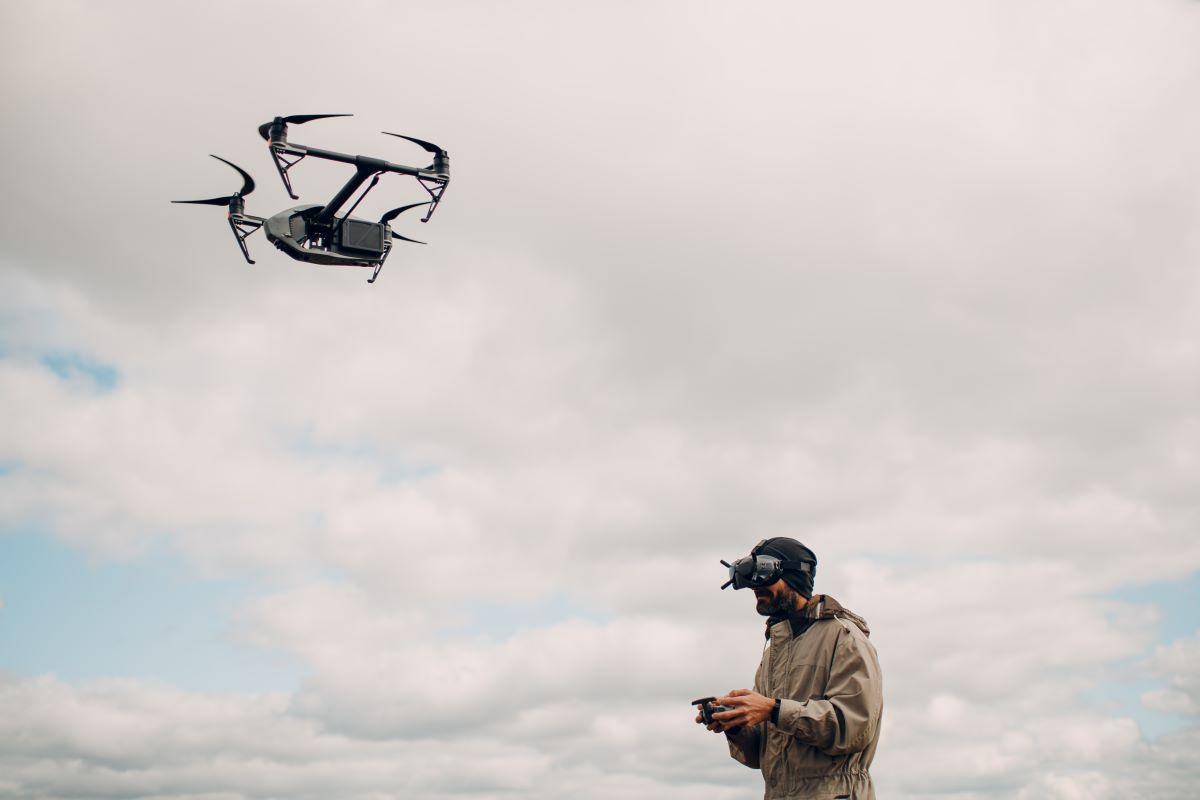
Aerial Video: The Evolution of Drone Technology
When Skyfall (2012), the 23rd James Bond film, hit theaters, it illustrated stunning action sequences and gripping storytelling along with a revolutionary approach to filming aerial footage. In one of the film’s most memorable opening scenes, director Sam Mendes and his team used drones to film breathtaking aerial shots of Istanbul, marking a turning point in cinematic technology. These were among the first major uses of drones for aerial footage in a Hollywood film, replacing the traditional use of helicopters and cranes that had dominated previous productions. The decision to use drones allowed the filmmakers to capture shots with precision and agility, something that was previously difficult, if not impossible, with older equipment.
Since then, drones have become an increasingly common resource for filmmakers and video production companies. The ease of use, affordability, and ability to create aerial video have contributed to the growing popularity of drones in various forms of media. What was once a luxury reserved for high-budget productions is now available to filmmakers at all levels, giving them creative freedom to explore new perspectives and techniques. This article will explore the evolution of drone technology in filmmaking, focusing on the technological innovations, creative applications, and how drones are shaping the future of video production.
The Rise of Drones in Filmmaking
Drone technology in filmmaking has experienced remarkable growth in the past two decades. Initially, the idea of using drones for film production was more a novelty than a necessity. Early on, the primary method of capturing aerial video involved expensive helicopters, cranes, or specialised rigs, which were logistically complex and required significant budgets.
However, with the introduction of drones, filmmakers were suddenly able to access aerial cinematography at a fraction of the cost and with much more flexibility. Drones are lightweight, easily transportable, and can capture footage in tight spaces where traditional equipment would struggle. This accessibility has democratised aerial videos, allowing smaller production companies to achieve the same high-quality shots that were previously available only to big-budget productions.
The compact nature of drones also allows filmmakers to be more creative. They are able to experiment with dynamic angles, follow moving subjects, and navigate complex environments—tasks that would have been difficult or impossible using traditional methods. As technology improved, so too did the ability of drones to deliver cinematic-quality footage, making them an indispensable resource in filmmaking.
Technological Innovations in Drones
Over the years, drone technology has evolved significantly, with innovations that have improved both performance and versatility.
Camera Advancements
Early drones were often equipped with low-resolution cameras that were limited in their ability to capture high-quality footage. As drone technology advanced, the cameras they carried evolved as well, reaching resolutions of 4K and even 8K. These advancements have made drones more accessible and competitive with traditional film equipment used in high-budget productions. Today, drones can capture stunning aerial video that rivals helicopters and cranes, offering filmmakers flexibility without sacrificing quality.
Stabilisation and Gimbals
In the early days of drone cinematography, footage was often shaky and inconsistent. However, advances in stabilisation technology, such as gimbals, have allowed for smooth, steady footage even in challenging flying conditions. These systems ensure that the drone’s camera remains level and stable during flight, providing high-quality shots even when navigating complex or windy environments.
Flight Systems and GPS
Modern drones are equipped with advanced flight systems, including precise GPS tracking, obstacle detection, and automated flight paths. These systems allow drones to execute smooth, repeatable shots with accuracy, even in difficult environments. Production companies can now programme drones to fly along predetermined paths, follow specific subjects, or film dynamic movements, which was not possible in the early stages of drone use. This precision is especially useful for creating complex shots that involve moving through tight spaces or capturing fast-paced action sequences.
Creative Applications of Drones in Filmmaking
One of the main reasons drones have become so popular in filmmaking is their ability to provide fresh, creative perspectives that were previously difficult to achieve.
Aerial Views
The most obvious use for drones is capturing sweeping aerial shots that provide a broader perspective of the setting. Whether filming vast landscapes or cities, drones allow filmmakers to establish a sense of scale and grandeur, all while giving the audience a unique view that traditional cameras cannot achieve. These shots can provide valuable context for the viewer, offering a sense of place and an emotional connection to the environment.
Dynamic Tracking and Action Sequences
Drones are also used for dynamic tracking shots, following characters or objects through difficult terrains. This is particularly useful in fast-paced scenes or action sequences. Drones can easily maneuver through tight spaces and keep pace with moving subjects, providing a level of flexibility that traditional camera rigs cannot match. For instance, drones were used to film the high-speed car chases in Mad Max: Fury Road (2015), capturing the intensity and scale of the scenes without the need for costly and cumbersome rigs.
Unique Angles
Drones have the ability to shoot aerial video from unconventional angles, such as directly overhead or in tight spaces, opening up a wealth of new creative opportunities. Filmmakers can use drones to weave intricate shots or create dramatic transitions, giving their work a distinctive visual style.
Behind the Scenes: The Drone Crew
While the technology behind drones is impressive, their success in video production is also a result of the skilled professionals who operate them. The role of the drone operator is critical, as they must navigate the drone through difficult environments while maintaining a steady shot. The coordination between the drone pilot and the camera operator is key to achieving the director’s vision, ensuring that the drone’s movements align with the video’s narrative and aesthetic.
In addition to piloting the drones, the crew is responsible for safety and risk management. Drone operators undergo extensive training to ensure that they can handle the equipment safely, especially when working in challenging or high-risk environments. Their ability to respond quickly and adapt to unexpected situations is crucial for successfully making an aerial video.
Legal and Safety Considerations
As drones have become more widely used in video production, there has been an increasing need for regulation and safety protocols. Production companies must adhere to airspace regulations, obtain permits, and ensure the safety of their crew and the public when operating drones. Many countries have strict rules in place regarding where and how drones can be flown, particularly in populated areas or near airports.
For example, the Federal Aviation Administration (FAA) in the United States has established clear guidelines for commercial drone use, including restrictions on flying drones above certain altitudes or near restricted airspace. Production teams must also ensure that their drone operations are conducted safely, which involves risk mitigation strategies such as conducting pre-flight checks and using spotters to monitor airspace during filming.
The Future of Drone Technology in Filmmaking
Looking ahead, drone technology is poised to continue evolving, offering even more exciting possibilities for video creators. One of the most promising areas of development is the integration of artificial intelligence (AI). AI could enable drones to make real-time adjustments during flight, optimising shots and even predicting the movement of subjects. Additionally, advancements in battery technology may extend flight times, giving production companies more flexibility during shoots.
Another exciting possibility is the use of drones in immersive experiences, such as virtual and augmented reality (VR and AR). Drones equipped with VR or AR capabilities could provide filmmakers with a real-time preview of how a shot will appear, allowing them to make adjustments on the spot and improve the overall production process.
Conclusion
Drone technology continues to evolve, becoming an indispensable tool in filmmaking. What started with the groundbreaking work seen in Skyfall has grown into an industry-standard method for filming aerial video. As drones improve, video production companies are finding even more creative ways to incorporate them into their work, whether it is for action sequences, sweeping landscapes, or tracking shots. The rapid advancements in technology promise even greater opportunities for production teams, making it clear that drones will remain an essential part of cinematic storytelling.
A notable example of drones pushing filmmaking to new heights is the use of aerial footage in The Revenant (2015), directed by Alejandro González Iñárritu. In one particularly striking sequence, drones were used to film from above the vast, snow-covered landscape, helping the film’s crew overcome the challenges of filming in remote, harsh conditions. This innovative approach enhanced the narrative and demonstrated how drones can open up new possibilities for directors and cinematographers. This growing field will undoubtedly inspire future storytellers to experiment with new techniques, and as it unfolds, the role of drones in shaping the visual language of film will only continue to expand.
If you’re interested in incorporating aerial video into your next project, Sound Idea Digital can guide you through the process. Get in touch to see how drone technology can enhance your videos.
We are a full-service Web Development and Content Production Agency in Gauteng specialising in Video Production, Animation, eLearning Content Development, Learning Management Systems, and Content Production.
Contact us for a quote. | enquiries@soundidea.co.za | https://www.soundideavideoproduction.co.za| +27 82 491 5824 |

